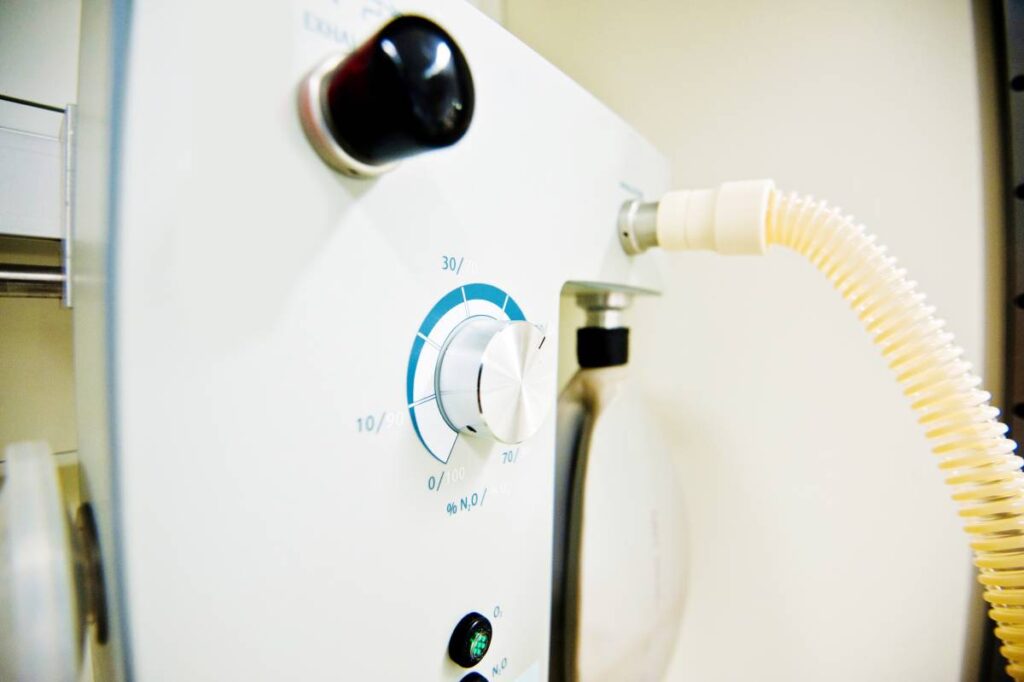Nitrous oxide, also known as N2O, is commonly used for anesthesia in dental and surgical procedures. Its mechanism of action involves depressing the central nervous system‘s activity. N2O stabilizes axonal membranes, partially inhibiting action potentials and leading to sedation. It may also interact with opiate receptor systems, providing mild analgesia. N2O is absorbed and exhaled through the lungs via gas exchange, with a small amount excreted through the skin. It acts rapidly when inhaled, with an onset of action within 2-5 minutes. Though previously widely used, there have been efforts to avoid nitrous oxide anesthesia, with substantial arguments both for and against its use.
Nitrous oxide affects respiratory, cardiovascular, cerebral, and gastrointestinal physiology in several important ways. Unlike many volatile anesthetic agents (e.g., desflurane) that can cause airway irritation, coughing, laryngospasm, or bronchospasm, it does not irritate the airways. In most patients, N2O induces minimal hemodynamic changes, partly because delivering high concentrations is not feasible under standard conditions. However, it may cause mild myocardial depression and stimulate the sympathetic nervous system, leading to slight increases in pulmonary vascular resistance. N2O can also increase cerebral blood flow and intracranial pressure. Prolonged administration of nitrous oxide may result in nausea and vomiting, as it diffuses into bowel gas and distends the gastrointestinal tract.
Nitrous oxide is used in various clinical settings and is delivered through a flow meter on the anesthesia machine. It is commonly chosen as a supplementary agent during the maintenance phase of general anesthesia. Its use can deepen the level of anesthesia, leading to a reduction in the required dosage of co-administered anesthetic agents. For maintenance of general anesthesia, any available inhalational anesthetic agents may be employed. The dosage of an inhalation agent required to maintain general anesthesia is determined by its potency, which is expressed as the minimal alveolar concentration (MAC). Concurrent administration of N2O during the maintenance phase of general anesthesia decreases MAC. Typically, a volatile anesthetic agent is administered with or without N2O as a supplementary agent to maintain general anesthesia. If necessary, a neuromuscular blocking agent may also be added to ensure complete immobility.
While there are several benefits of nitrous oxide anesthesia, there are also several drawbacks, with additional strong environmental arguments against its use. The advantages and disadvantages of N2O should be carefully considered for each patient. Advantages of N2O include the following:
– Pleasant smell and no airway irritation, useful for induction
– Rapid onset and offset of anesthesia
– Speedy recovery from anesthesia
– Enhancement of effects of other anesthetics
– Analgesic and anxiolytic properties
– Reduction in postoperative pain and hyperalgesia
– Minimal hemodynamic effects
– No significant biotransformation
– Low cost
Disadvantages of N2O include the following:
– Low potency, limited concentration
– Higher risk of postoperative nausea and vomiting
– Potential diffusion into gas-filled cavities
– Possible increased risk of atelectasis in patients with poor pulmonary function
– Potential for transient diffusion hypoxia
– Fire hazard
– Mild cardiovascular effects
– Not suitable for use in patients with certain vitamin deficiencies
– Potential for abuse
– Teratogenic effects in animal models
– Greenhouse gas, leading to adverse environmental consequences
Nitrous oxide is not recommended for patients with pre-existing conditions such as bowel distention, increased middle ear pressure, pneumothorax, pneumoperitoneum, pneumocephalus, intraocular gas, or venous air embolism. It is also typically avoided in patients with cardiomyopathy and pulmonary hypertension due to its potential to cause mild myocardial depression, sympathetic nervous system stimulation, and increased pulmonary vascular resistance. Furthermore, N2O is generally avoided in patients with vitamin B12 deficiency.
Finally, arguments against nitrous oxide anesthesia often center around its detrimental impacts on the environment as a greenhouse gas. Many anesthesiologists argue that alternative, non-inferior approaches are available, making N2O obsolete. Nonetheless, others argue that its unique characteristics and pharmacological profile are still valuable in certain contexts.
References
Schubert A, Licina MG, Lineberry PJ. The effect of ketamine on human somatosensory evoked potentials and its modification by nitrous oxide. Anesthesiology. 1990 Jan;72(1):33-9. doi: 10.1097/00000542-199001000-00007. Erratum in: Anesthesiology 1990 Jun;72(6):1104. PMID: 2297131.
Sun R, Jia WQ, Zhang P, et al. Nitrous oxide-based techniques versus nitrous oxide-free techniques for general anaesthesia. Cochrane Database Syst Rev. 2015 Nov 6;2015(11):CD008984. doi: 10.1002/14651858.CD008984.pub2. PMID: 26545294; PMCID: PMC9326975.
Buhre W, Disma N, Hendrickx J, et al. European Society of Anaesthesiology Task Force on Nitrous Oxide: a narrative review of its role in clinical practice. Br J Anaesth. 2019 May;122(5):587-604. doi: 10.1016/j.bja.2019.01.023. Epub 2019 Feb 22. PMID: 30916011.
Aldecoa C, Bettelli G, Bilotta F, et al. European Society of Anaesthesiology evidence-based and consensus-based guideline on postoperative delirium. Eur J Anaesthesiol. 2018 Sep;35(9):718-719. doi: 10.1097/EJA.0000000000000594. PMID: 28187050.
Berger M, Schenning KJ, Brown CH, et al. Best Practices for Postoperative Brain Health: Recommendations From the Fifth International Perioperative Neurotoxicity Working Group. Anesth Analg. 2018 Dec;127(6):1406-1413. doi: 10.1213/ANE.0000000000003841. PMID: 30303868; PMCID: PMC6309612.
Zorrilla-Vaca A, Healy RJ, Wu CL, et al. Relation between bispectral index measurements of anesthetic depth and postoperative mortality: a meta-analysis of observational studies. Can J Anaesth. 2017 Jun;64(6):597-607. English. doi: 10.1007/s12630-017-0872-6. PMID: 28361391.



